History
17th century
Thirty Years' War (1616–1648)
1626
On 1 May 1626, George William, Elector of Brandenburg, granted Oberst (colonel) Hildebrand von Kracht [ de ] the Kapitulation [ de ] of a regiment of foot consisting of 3,000 men in 15 companies.
On May 1, a muster took place for nine companies near Frankfurt (Oder), until June for the other companies (also in Brandenburg towns).
On October 13, the Elector issued patents for 14 new companies due to the Swedish threat to Prussia, 5 of which were to form the Leib Regiment together with 5 of Kracht's regiment, while 9 others joined the Kracht Regiment, which thus had 19 companies. The Leib regiment reached the strength of nine companies. However, the regiment's formation (like that of the Leib Regiment) was hampered when the Elector took most of the troops from the Margraviate of Brandenburg to Duchy of Prussia in December 1626, namely the regimental staff and 12 companies of the Kracht Regiment, among others.
In 1627 Kracht returned to the Marches, and on 26 September (6 October) 1627 he was relieved of command of his regiment in Prussia.
1629
On 16/26 September 1629, the Truce of Altmark was signed, according to which Memel (now Klaipėda), Pillau (now Baltiysk) and other places remained in Swedish hands, in return for which the Elector received Marienburg (now Malbork), Stuhm (now Sztum) and other places previously occupied by this regiment.
On 28 November (8 December) 1629, the regiment's former Oberstleutnant (lieutenant colonel), Streiff von Lauenstein, became its colonel; after its Kapitulation (19 February 1630), it was to have 8 companies; 3 of these were lost by 1632.
1 June 1635: these 5 remaining companies, of which the regiment currently consisted, came to Memel when the Elector regained its fortress through the Treaty of Stuhmsdorf.
Two companies moved to Pillau on 5/15 January 1636 and three more in 1639.
Late 17th century
After the Thirty Years' War, the regiment was involved in the Second Northern War (1658–1660) and the Great Turkish War (1684–1686; 1693–1698).
On 28 September 1657, the 2 companies in Memel left the regimental association with the 3 companies in Pillau. The two companies joined the four-company Electoral "Leibguardi" under Oberst de la Cave; this association was dissolved on 9 June 1660.
In 1675, the number of companies in Pillau was increased to 4, and in 1687 to 6 companies.
In 1689, the Elector often reorganised the fortress garrisons so that they formed two battalions (a field battalion and a garrison battalion), as a result of which the Pillau companies also became a regiment of two battalions of five companies each; the garrison battalion was later reduced in size. In 1689, the field battalion moves to the Rhine for the campaign against France in the Nine Years' War.
On 1/11 April 1692, this battalion became an independent regiment when the former governor of Pillau and colonel (chief) von Brandt of its garrison relinquished the governing of Pillau, became governor of Magdeburg and received 3 companies of his regiment from his successor in Pillau, Count Alexander Dohna, in return for which the companies still in Pillau (3) became the 5th Regiment [ de ].
18th century
The regiment fought in the War of the Spanish Succession (1702–1713). In early 1713, Frederick William I of Prussia permanently set the strength of most infantry regiments, including this regiment, at two battalions of 5 companies each.
The regiment was involved in the Great Northern War (1715–16) and the War of the Polish Succession (1734).
From 29 March 1735, the grenadiers, who had previously been distributed among the companies, were merged into 2 companies. So, the regiments now consisted of 2 battalions, each of one grenadier and 5 musketeer companies. In the event of mobilisation, the grenadier companies of two regiments each merged into one grenadier battalion.
1780s
There was a reorganization on 27 February 1787, when two musketeer companies were transformed into grenadier companies, so that the regiment now consists of one grenadier and two musketeer battalions, four companies each. On 14 February 1788, it was determined that each infantry regiment should receive a depot battalion on June 1, which would only accept those still able to serve in garrison and would serve as a replacement battalion in war. The garrison regiments that existed previously were disbanded, so the regiment received three companies of von Bose [ de ]'s 1st Garrison Regiment [ de ] as a depot battalion.
1790s
The regiment was involved in fighting against the Polish-Lithuanian Uprising of 1794.
On 1 October 1797, the depot battalions were given a 4th company and (from January 1796) the name 3rd Musketeer Battalion, although their purpose remained essentially the same.
On 28 February 1799, the regiment was restructured by converting two grenadier companies into musketeer ones, meaning the regiment possessed only two grenadier companies and its 1st and 2nd musketeer battalions had 5 companies, while the 3rd musketeer battalion had 4. The grenadiers of two regiments unified to form a grenadier battalion. The regiment's grenadiers formed a battalion with those of the 5th Regiment, which was called von Fabecki in 1806.
19th century
Napoleonic Wars
The regiment fought against France in the War of the Fourth Coalition (1806–1807). On 20 November 1807, the 21st Fusilier Battalion of Stutterheim was assigned as a light battalion to the aforementioned grenadier battalion.
It was part of the Yorck Corps that invaded Russia alongside the French. The regiment then fought in the War of the Sixth Coalition (1813–1814) against France in Bülow's Corps, later the III Army Corps.
In 1813, a 3rd musketeer battalion and three reserve battalions were established and the musketeer battalion, the 1st and 2nd reserve battalions were transferred to another regiment.
On 14 October 1814, the two grenadier companies were transferred to the Alexander Regiment, where they became the 9th and 10th companies. This was followed in 1859 by heavy transfers (including of officers) to the 44th Regiment.
On 17 August 1914, the regiment was mobilised in accordance with the mobilisation plan. It belonged to the 3rd Infantry Brigade, the 2nd Division, the 8th Army and the I Corps. In addition to the regiment moving into the field, it provided a replacement battalion of four companies and two recruit depots.
On 29 August 1918, the regiment received its own mine launcher company, which was formed from parts of 2nd Mine Launcher Company.

Fusilier is a name given to various kinds of soldiers; its meaning depends on the historical context. While fusilier is derived from the 17th-century French word fusil – meaning a type of flintlock musket – the term has been used in contrasting ways in different countries and at different times, including soldiers guarding artillery, various elite units, ordinary line infantry and other uses.
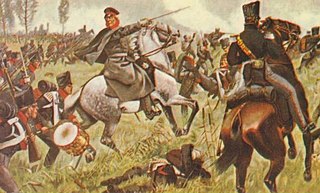
The Battle of Wartenburg took place on 3 October 1813 between the French IV Corps commanded by General Henri Gatien Bertrand and the Allied Army of Silesia, principally the I Corps of General Ludwig von Yorck. The battle allowed the Army of Silesia to cross the Elbe, ultimately leading to the Battle of Leipzig.
The 1st Division was a unit of the Prussian/German Army. It was formed in Königsberg in March 1816 as a Troop Brigade (Truppen-Brigade). It became the 1st Division on September 5, 1818. From the corps' formation in 1820, the division was subordinated in peacetime to I Army Corps. The 1st Division was disbanded in 1919, during the demobilization of the German Army after World War I.
The 2nd Division was a unit of the Prussian/German Army. It was formed in Danzig in March 1816 as a Troop Brigade (Truppen-Brigade). It became the 2nd Division on September 5, 1818. In 1890, the headquarters of the division was relocated to Königsberg, then the capital of East Prussia. In 1899, the headquarters was moved to Insterburg, further inland and closer to the border with the Russian Empire. From the latter's formation in 1820, the division was subordinated in peacetime to the I Army Corps. The 2nd Division was disbanded in 1919 during the demobilization of the German Army after World War I.
The 3rd Division was a unit of the Prussian/German Army. It was formed in Stettin in May 1816 as a Troop Brigade (Truppen-Brigade). It became the 3rd Division on September 5, 1818. From the corps' formation in 1820, the division was subordinated in peacetime to the II Army Corps. The 3rd Division was disbanded in 1919 during the demobilization of the German Army after World War I.
The 28th Division was a unit of the Prussian and German Army, almost entirely made up of troops from the Grand Duchy of Baden. It was formed in Karlsruhe on 1 July 1871. The division was subordinated in peacetime to the XIV Army Corps. The 28th Division was disbanded in 1919 during the demobilization of the German Army after World War I.
This is an order of battle of the French and German Armies at the beginning of the Franco-Prussian War in 1870.
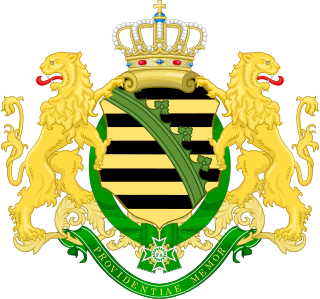
The Royal Saxon Army was the military force of the Electorate (1682–1807) and later the Kingdom of Saxony (1807–1918). A regular Saxon army was first established in 1682 and it continued to exist until the abolition of the German monarchies in 1918. With the formation of the Confederation of the Rhine by Napoleon the Royal Saxon Army joined the French "Grande Armée" along with 37 other German states.
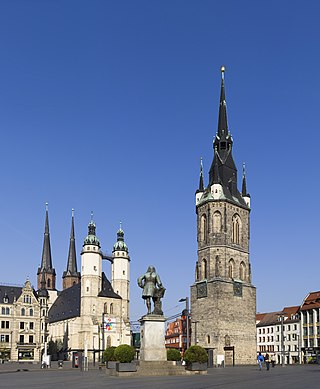
In the Battle of Halle on 17 October 1806 a French corps led by Jean-Baptiste Bernadotte fought the Prussian Reserve under Eugene Frederick Henry, Duke of Württemberg. The French defeated their opponents, forcing the Prussians to retreat northeast toward Dessau after suffering heavy losses. The clash occurred in the War of the Fourth Coalition, part of the Napoleonic Wars. The city of Halle is located about 30 kilometers northwest of Leipzig on the Saale River.

In the Battle of Prenzlau or Capitulation of Prenzlau on 28 October 1806 two divisions of French cavalry and some infantry led by Marshal Joachim Murat intercepted a retreating Prussian corps led by Frederick Louis, Prince of Hohenlohe-Ingelfingen. In this action from the War of the Fourth Coalition, Hohenlohe surrendered his entire force to Murat after some fighting and a parley. Prenzlau is located about 90 kilometers north of Berlin in Brandenburg.
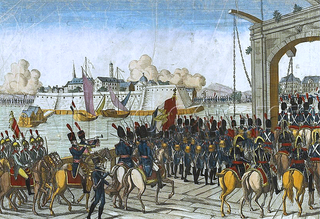
In the Capitulation of Stettin on 29–30 October 1806, Lieutenant General Friedrich Gisbert Wilhelm von Romberg surrendered the garrison and fortress to a much smaller French light cavalry brigade led by General of Brigade Antoine Lasalle. This event was one of a number of surrenders by demoralized Prussian soldiers to equal or inferior French forces after their disastrous defeat at the Battle of Jena-Auerstedt on 14 October. Stettin, now Szczecin, Poland, is a port city on the Oder River near the Baltic Sea, about 120 kilometres (75 mi) northeast of Berlin.

In the siege of Hamelin or siege of Hameln, First French Empire forces captured the fortress of Hamelin from its garrison composed of troops from the Kingdom of Prussia. The siege was begun by the VIII Corps under French Marshal Édouard Adolphe Casimir Joseph Mortier. The marshal initially left General of Division Jean-Baptiste Dumonceau in charge of operations. General of Division Anne Jean Marie René Savary soon arrived to conduct negotiations with the Prussian commander General Karl Ludwig von Lecoq, who was quickly persuaded to surrender. Technically, the operation from the War of the Fourth Coalition was a blockade because a formal siege never took place. Hamelin is located 36 kilometers southwest of Hanover.
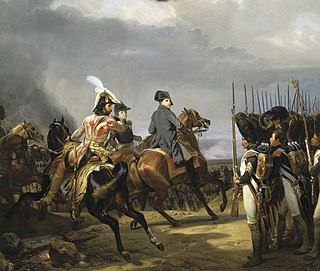
The Jena-Auerstedt campaign order of battle is listed below. The order of battle includes units from the First French Empire and the Kingdom of Prussia that fought each other in the campaign that included the decisive Battle of Jena-Auerstedt on 14 October 1806. The order of battle may be useful to trace the battles of Schleiz and Saalfeld, which occurred before Jena-Auerstedt, as well as battles and capitulations that happened after 14 October, such as Erfurt, Halle, Prenzlau, Pasewalk, Stettin, Waren-Nossentin, and Lübeck.

The Battle of Czarnowo on the night of 23–24 December 1806 saw troops of the First French Empire under the eye of Emperor Napoleon I launch an evening assault crossing of the Wkra River against Lieutenant General Alexander Ivanovich Ostermann-Tolstoy's defending Russian Empire forces. The attackers, part of Marshal Louis-Nicolas Davout's III Corps, succeeded in crossing the Wkra at its mouth and pressed eastward to the village of Czarnowo. After an all-night struggle, the Russian commander withdrew his troops to the east, ending this War of the Fourth Coalition action. Czarnowo is located on the north bank of the Narew River 33 kilometres (21 mi) north-northwest of Warsaw, Poland.
The VIII Corps of the Grande Armée was a French military unit that existed during the Napoleonic Wars. Emperor Napoleon I formed it in 1805 by borrowing divisions from other corps and assigned it to Marshal Édouard Mortier. Marshal André Masséna's Army of Italy was also reorganized as the VIII Corps at the end of the 1805 campaign. The corps was reformed for the 1806 campaign under Mortier and spent the rest of the year mopping up Prussian garrisons in western Germany.
Friedrich Julius von Hassel was a Lieutenant general in the Prussian army. He spent most of his life as Friedrich Julius Hassel, but was raised to the Nobility by the emperor in 1887. His grandson, Kai-Uwe von Hassel, served as the West German Minister of Defence between 1963 and 1966.

The 8th Estonia Infantry Regiment was an infantry regiment of the Imperial Russian Army.
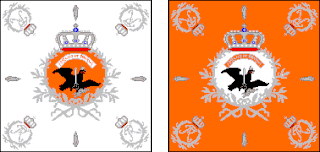
The 1st Prussian Infantry Regiment was a line infantry regiment of the Old Prussian Army which had initially formed part of the Prussian Life Guard, but later transferred to the line. After notably serving in the War of the Austrian Succession and Seven Years' War, the regiment was demolished following the Battle of Auerstadt. A small part of the regiment went on to help form the famed 8th Life Infantry Regiment, which in turn would serve notably till its disbandment after World War I.
The First Army was a Prussian formation during the Austro-Prussian War. Being a wartime organization of the Prussian Army; it afterwards was demobilized.










